Facial fillers have become a popular non-surgical cosmetic procedure, offering individuals the opportunity to enhance their features and achieve a more youthful appearance. However, the question of whether it’s safe to fly after getting facial fillers has garnered attention. In this blog post, we’ll delve into the potential risks and complications associated with flying after facial fillers, drawing insights from medical professionals and experts in the field.
Understanding the Risks: Flying after facial fillers, whether it’s lip fillers, cheek fillers, or under-eye fillers, involves certain risks that individuals should be aware of to ensure their safety and well-being.
Changes in Air Pressure:
Flying at high altitudes results in changes in air pressure inside the airplane cabin. This alteration can adversely affect facial fillers, causing them to expand or shift from their original placement. This can lead to uneven or lumpy results, making corrections challenging.
Dehydration and Skin Issues:
Recycled air in airplanes may have low humidity levels, leading to skin dehydration. Dehydrated skin can impact the longevity of filler injections and decrease skin elasticity. Moreover, exposure to germs and bacteria in the recirculated air can increase the risk of infections at the injection sites.
Fluid Retention and Swelling:
Extended periods of sitting during flights can induce fluid retention and increased swelling in the body. This heightened swelling may exacerbate the side effects of facial fillers, leading to discomfort, bruising, or uneven results.
Blood Circulation and Clotting:
Prolonged sitting during flights can affect blood circulation, potentially increasing the risk of blood clots or deep vein thrombosis. This is especially concerning for individuals who have undergone neck or chin filler procedures.
Specific Risks for Lip Fillers: Flying after getting lip fillers comes with additional considerations due to the nature of the treatment. Swelling, discomfort, and infection are among the primary risks associated with flying immediately after lip injections.
How Soon Can You Fly After Lip Fillers? To minimize risks, it is generally recommended to wait at least 24 to 48 hours after getting lip fillers before flying. This allows time for swelling and bruising to subside, reducing the potential for complications during the flight.
Facial Filler Aftercare: Proper aftercare is crucial to ensure a smooth recovery, especially if planning to travel shortly after getting dermal fillers. This includes applying ice packs, maintaining cleanliness to prevent infections, and avoiding strenuous activities that may impact the treated areas.
Conclusion: While facial fillers offer an effective way to enhance one’s appearance, it’s important to be mindful of the potential risks associated with flying after the procedure. Understanding these risks and following recommended aftercare instructions can contribute to a safer and more comfortable journey post-filler injections. As always, consulting with your healthcare provider for personalized advice is essential for a worry-free experience. To learn more about what Botox can do for you, schedule a free consultation with one of our master injectors.

